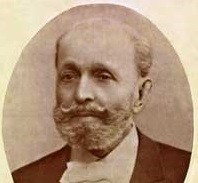Marius PetipaChoreographerMarius Petipa, the "father of classical ballet," was born in Marseilles, France, in 1819. He began his dance training at the age of seven with his father, Jean Petipa, the French dancer and teacher. Marius was educated at the Grand College in Brussels and also attended the conservatoire, where he studied music.
In 1834 Jean Petipa became Maitre de Ballet at the theatre in Bordeaux and it was here that Marius completed his education. At the age of sixteen, he became premier danseur at the theatre in Nantes, where he also produced several short ballets. In 1839 Marius left Nantes to tour North America with his father, and on their return visit went to Paris. The following year he made his debut at the Comedie Francaise, where he partnered Carlotte Grisi in a benefit performance. He continued his studies with A. Vestris and became a principal dancer in Bordeaux. As a principal dancer, Petipa often appeared with Fanny Elssler and was much acclaimed for his performances in such ballets as Paquita (which he restaged and in which made his debut), Giselle, La Peri, Armida, Catarina, Le Delire d'un peintre, Esmeralda, Le Corsaire and Faust. Considered an excellent dancer and partner, his acting, stage manners and pantomime were held up as examples for many generations of dancers. Sources differ on the first original work he staged for the Imperial Theatre: some state it was The Star of Granada, others that it was A Marriage During Regency. But all sources concur that his first great success was The Daughter of Pharoh (staged in six weeks), which resulted in his appointment as Choreographer-in-Chief in 1862 -- a position he held for nearly fifty years. In 1869 Petipa became Premier Ballet Master of the Imperial Theatre. The value of his accomplishments is inestimable: he produced more than sixty full-evening ballets and innumerable shorter works and he is considered to have laid the foundation for the entire school of Russian ballet. The ballet repertoire in the Soviet Union is still based mainly on his works. Those who felt the dramatic content of ballet should be strengthened began to oppose Petipa toward the end of his career. His noble classicism and consciousness of form was considered old-fashioned, and in 1903, at age 84, Petipa was forced to retire from the Imperial Theatre as a direct result of the failure of his ballet, The Magic Mirror. His last years were filled with bitterness and disillusionment because his beloved theatre had been taken away. He died in St. Petersburg in 1910. © http://www.abt.org © wikipedia |


